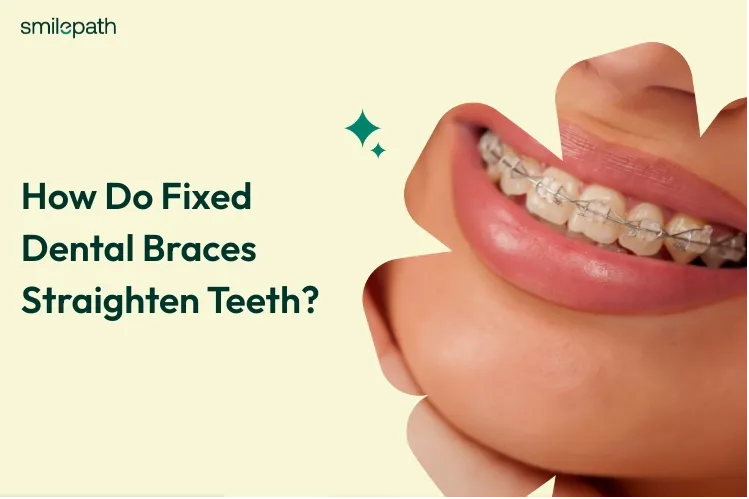
Fixed dental braces are a traditional solution to misaligned teeth. But you might be asking yourself, “How do braces work? How do braces move teeth?”
To help you choose the best possible teeth aligner, let’s answer these questions and explore the different types of dental braces currently available. That way, you can enjoy a confident smile comfortably and quickly.
Without further ado, read on to find the answer to the important question: What are fixed dental braces?
What Are Fixed Dental Braces?
Fixed dental braces are typically made of metal. They adhere to the surface of teeth and cannot be removed by the wearer. That’s because they’re secured using special dental cement and a UV light.
Just as with any other type of dental braces, fixed braces are designed to straighten teeth. To do this, they rely on metal wires, pressure, and time.
How Do Metal Braces Work?
The process of getting metal braces consists of several steps. Additionally, individuals with metal braces can expect to wear them for anywhere between one and several years.
Initially, an orthodontist will perform an exam and determine which teeth should be shifted and when. In some cases, thick rubber bands may be placed between some teeth to form spaces between them.
This makes it easier for the orthodontist to install and secure brackets onto the teeth. This step can be irritating to the gums but is generally painless.
When the teeth are prepared and adequately spaced, the orthodontist places brackets onto the centre surface of the teeth. Then, dental cement is applied to the teeth to keep these brackets secure.
After this step, the orthodontist will thread a metal wire through the small loop in each bracket, tightening and shifting the wire to pull against the teeth. Over time, this combination of brackets and wire can move the teeth.
How Much Do Dental Braces Cost?
The cost of dental braces varies depending on the practice and the patient. For example, those with significant misalignment are likely to spend more on braces than those correcting individual teeth.
The process of straightening teeth with metal braces is often a long, drawn-out one. Each wire threaded through the metal brackets represents a new shift in direction.
Patients with many gaps or crooked teeth may need to visit their orthodontist each month for years. This necessary interaction is sure to increase overall treatment costs.
Still, according to Oral-B, the average cost for fixed metal braces is about $5,000. That’s a hefty price tag, especially for a treatment that can result in painful sores and bleeding lips.
Are Metal Braces Painful?
Getting braces isn’t usually a painful process, but metal braces can be irritating. The metal brackets placed on the surface of your teeth can scrape against the inside of your lips, causing sores and bleeding.
The orthodontic wire threaded through these brackets can also trap bits of food. Attempting to tongue away these bits of gunk can result in a reddened and irritated tongue.
Dental wax for braces is commonly used to help reduce the discomfort of wearing fixed braces. These small pieces of wax are flattened and pushed against the brackets to form a smooth, non-irritating surface.
However, dental wax doesn’t stay in place for very long. It’s also not designed for multi-day usage. As such, preventing irritation and pain isn’t always possible or practical.
Fortunately, fixed dental braces aren’t the only solution to misaligned teeth.
Are There Alternatives to Metal Braces?
There are quite a few alternatives to metal braces. But perhaps the most popular choice is clear teeth aligners. These removable misaligned teeth braces are generally less painful than traditional metal options.
Additionally, clear aligners are virtually invisible. While metal braces are challenging to miss, individuals wearing clear aligners might appear to have nothing at all on their teeth.
Clear aligners work by putting gentle force on specific teeth to result in a straighter, healthier smile. Overall, clear dental aligners are a convenient and pain-free alternative to traditional metal braces.
It’s essential to consider the potential benefits of clear aligners before consulting with an orthodontist. Your pathway to a more confident smile might start with an at-home impressions kit rather than metal wires.
What Are the Benefits of Using Teeth Aligners?
There are several advantages of using clear aligners over metal braces. Some of the most notable of these include:
- Shorter Treatment Time
- Less Noticeable Treatment
- Agency Over Removal
- Fewer Painful Symptoms
According to research published in the BMC Oral Health Journal, “patients treated with clear aligners
And because clear aligners are transparent, patients can wear them without drawing attention to their treatment. You can also remove clear aligners while eating or sleeping, something that’s not possible with metal braces.
Importantly, clear aligners don’t have any irritating metal components. Instead, they fit like a glove over your teeth, applying minimal pressure to shift them slowly.
As such, you won’t need special dental wax to keep your lips safe. What’s even more impressive is how convenient clear aligners can be. Instead of making regular trips to your orthodontist, you could order aligners online.
Enjoy a More Confident Smile
Fixed metal braces use cemented brackets and threaded wires to slowly correct dental misalignments. However, these components can irritate the soft tissue inside the mouth, including the lips and tongue.
But there are painless alternatives to traditional metal braces, most notably clear aligners. These removable, transparent teeth straightening tools could be the better choice to help you enjoy a brighter, more confident smile.
Are you ready to start your journey toward a healthier smile? If so, please take advantage of this free assessment today!


 Australia
Australia New Zealand
New Zealand Malaysia
Malaysia English
English Portuguese
Portuguese English
English English
English English
English English
English English
English Canada
Canada